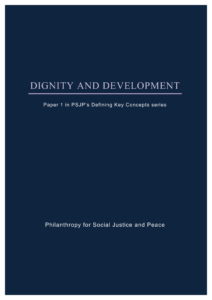 This paper looks at the idea of ‘dignity’ and forms part of PSJP’s series on ‘defining key concepts’ in development and philanthropy. The 1948 Declaration of Human Rights enshrined dignity as the central goal of development, yet the term is not clearly defined, which makes it difficult to pursue and impossible to measure. Different people and organizations committed to the pursuit of dignity are likely to have different understandings of the term. The aim of this paper is to come up with a clearer definition of dignity and to begin to explore approaches to measuring it. We hope this will help people working in the field to improve their practice and increase the impact of what they do.
This paper looks at the idea of ‘dignity’ and forms part of PSJP’s series on ‘defining key concepts’ in development and philanthropy. The 1948 Declaration of Human Rights enshrined dignity as the central goal of development, yet the term is not clearly defined, which makes it difficult to pursue and impossible to measure. Different people and organizations committed to the pursuit of dignity are likely to have different understandings of the term. The aim of this paper is to come up with a clearer definition of dignity and to begin to explore approaches to measuring it. We hope this will help people working in the field to improve their practice and increase the impact of what they do.
The data for this article is drawn from three webinars, held by PSJP on 11 July 2018, which enabled in-depth discussions among a total of 14 people from different kind of organizations, including social services, human rights and community philanthropy. All the discussants were part of a grants programme designed to increase human dignity, and data from the programme is used to supplement the discussions.
The paper traces the origins of the idea of dignity in development and then sets to unpack its implications in practice. It identifies two key frames for understanding dignity in development & philanthropy. 1) In our methods of work: how do we treat people? 2) In our goals and outcomes: does our work #ShiftThePower to communities or does it take power and agency away from them? Further sections discuss practices and behaviours that reduce dignity; ways in which we can ensure dignity in development practices; ideas on how to measure dignity; and what we can do to advance the dignity lens in development.
Although our aim in this paper is to define the idea of dignity, we are trying to stimulate a conversation about this rather than to be definitive. Our hope is that practitioners will share with us their understandings of the term dignity; any tips or tools they have encountered or developed for addressing their work through a dignity lens; the challenges they experience in this work; and the ways they are trying to assess how well they are doing. We would very much welcome your thoughts, which could be published as blogs or comments on the PSJP website.
This paper is based on research by Barry Knight and Chandrika Sahai for PSJP.
To comment or to take part in discussion on this topic, please write to chandrika@psjp.org